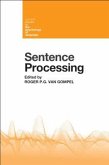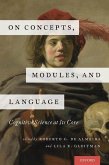Lila Gleitman
Sentence First, Arguments Afterward
Essays in Language and Learning
Herausgeber: Lidz, Jeffrey
Lila Gleitman
Sentence First, Arguments Afterward
Essays in Language and Learning
Herausgeber: Lidz, Jeffrey
- Gebundenes Buch
- Merkliste
- Auf die Merkliste
- Bewerten Bewerten
- Teilen
- Produkt teilen
- Produkterinnerung
- Produkterinnerung
Sentence First, Arguments Afterward collects the important papers of Lila Gleitman, a pioneer of the field of cognitive science. The book explores language from the perspective of language acquisition, linguistic relativity, and the very nature of syntax and semantics. Gleitman reveals insights that are important both for their perspective on the history of the field and for current practice in the study of language and thought.
Andere Kunden interessierten sich auch für
![Oxford Handbook of Cognitive Science Oxford Handbook of Cognitive Science]() Oxford Handbook of Cognitive Science241,99 €
Oxford Handbook of Cognitive Science241,99 €![Reenacting the Enemy Reenacting the Enemy]() Ludmila IsurinReenacting the Enemy98,99 €
Ludmila IsurinReenacting the Enemy98,99 €![Sentence Processing Sentence Processing]() Sentence Processing202,99 €
Sentence Processing202,99 €![Language Production Language Production]() Language Production178,99 €
Language Production178,99 €![On Concepts, Modules, and Language On Concepts, Modules, and Language]() On Concepts, Modules, and Language108,99 €
On Concepts, Modules, and Language108,99 €![Foundations of Stuttering Foundations of Stuttering]() Marcel WingateFoundations of Stuttering157,99 €
Marcel WingateFoundations of Stuttering157,99 €![Arguments for and against early therapeutic intervention for children with language disorders Arguments for and against early therapeutic intervention for children with language disorders]() Sebastian A. WagnerArguments for and against early therapeutic intervention for children with language disorders15,95 €
Sebastian A. WagnerArguments for and against early therapeutic intervention for children with language disorders15,95 €-
-
-
Sentence First, Arguments Afterward collects the important papers of Lila Gleitman, a pioneer of the field of cognitive science. The book explores language from the perspective of language acquisition, linguistic relativity, and the very nature of syntax and semantics. Gleitman reveals insights that are important both for their perspective on the history of the field and for current practice in the study of language and thought.
Hinweis: Dieser Artikel kann nur an eine deutsche Lieferadresse ausgeliefert werden.
Hinweis: Dieser Artikel kann nur an eine deutsche Lieferadresse ausgeliefert werden.
Produktdetails
- Produktdetails
- Verlag: Hurst & Co.
- Seitenzahl: 920
- Erscheinungstermin: 30. Juli 2020
- Englisch
- Abmessung: 218mm x 140mm x 18mm
- Gewicht: 340g
- ISBN-13: 9780199828098
- ISBN-10: 0199828091
- Artikelnr.: 59477689
- Herstellerkennzeichnung
- Libri GmbH
- Europaallee 1
- 36244 Bad Hersfeld
- 06621 890
- Verlag: Hurst & Co.
- Seitenzahl: 920
- Erscheinungstermin: 30. Juli 2020
- Englisch
- Abmessung: 218mm x 140mm x 18mm
- Gewicht: 340g
- ISBN-13: 9780199828098
- ISBN-10: 0199828091
- Artikelnr.: 59477689
- Herstellerkennzeichnung
- Libri GmbH
- Europaallee 1
- 36244 Bad Hersfeld
- 06621 890
Lila R. Gleitman is Professor Emerita of Psychology and Linguistics at the University of Pennsylvania. She is a member of the National Academy of Sciences and a fellow of the American Psychological Association and the Association for Psychological Science, among other honors. She was president of the Linguistic Society of America in 1993 and won the David Rumelhart Prize in 2017. Spanning six decades, Gleitman's work has shaped our understanding of language and cognition, as well as the relation between these domains. She is best known for her work showing that children's sensitivity to syntactic structure plays a critical role in their acquisition of verb meanings. Jeffrey Lidz is Distinguished Scholar-Teacher and Professor of Linguistics at the University of Maryland, having previously held positions at Northwestern University, the University of Pennsylvania, and CNRS Paris. Lidz's research explores language acquisition from the perspective of comparative syntax and semantics, focusing on the relative contributions of experience, extralinguistic cognition, and domain-specific knowledge in learners' discovery of linguistic structure. Lidz was co-editor of the Oxford Handbook of Developmental Linguistics (2016) and is Editor-in-Chief of Language Acquisition: A Journal of Developmental Linguistics.
* Section I. PRELIMINARIES * Foreword by Noam Chomsky * Chapter 1. From Structuralism to Cognitive Science: Lila R. Gleitman's Contributions to Language and Cognition
Jeffrey Lidz * Section II. WHAT DO THEY KNOW AND WHEN DID THEY KNOW IT? * Chapter 2. The Impossibility of Language Acquisition (And How They Do It)
Lila R. Gleitman
Mark Y. Liberman
Cynthia A. McLemore
and Barbara H. Partee * Chapter 3. A Study in the Acquisition of Language: Free Responses to Commands
Elizabeth F. Shipley
Carlota S. Smith
and Lila R. Gleitman * Chapter 4. The Emergence of the Child as Grammarian
Lila R. Gleitman
Henry Gleitman
and Elizabeth F. Shipley * Chapter 5. Language Use and Language Judgment
Henry Gleitman and Lila R. Gleitman * Section III. WHERE DOES LANGUAGE KNOWLEDGE COME FROM? INPUT AND INNATENESS * Chapter 6. Mother
I'd Rather Do It Myself: Some Effects and Non-Effects of Maternal Speech Style
Elissa L. Newport
Henry Gleitman
and Lila R. Gleitman * Chapter 7. Beyond Herodotus: The Creation of Language by Linguistically Deprived Deaf Children
Heidi Feldman
Susan Goldin-Meadow
and Lila R. Gleitman * Chapter 8. Every Child an Isolate: Nature's Experiments in Language Learning
Lila R. Gleitman and Barbara Landau * Section IV. HARD WORDS AND SYNTACTIC BOOTSTRAPPING A: ESTABLISHING PLAUSIBILITY * Chapter 9. Structural Sources of Verb Learning
Lila R. Gleitman * Chapter 10. On the Semantic Content of Subcategorization Frames
Cynthia Fisher
Lila R. Gleitman
and Henry Gleitman * Chapter 11. Human Simulations of Vocabulary Learning
Jane Gillette
Lila R. Gleitman
Henry Gleitman
and Anne Lederer * Section V. HARD WORDS AND SYNTACTIC BOOTSTRAPPING B: BUT IS IT TRUE? * Chapter 12. Understanding How Input Matters: Verb Learning and the Footprint of Universal Grammar
Jeffrey Lidz
Lila R. Gleitman
and Henry Gleitman * Chapter 13. Hard Words
Lila R. Gleitman
Kimberly Cassidy
Anna Papafragou
Rebecca Nappa
and John C. Trueswell * Chapter 14. When We Think About Thinking: The Acquisition of Belief Verbs
Anna Papafragou
Kimberly Cassidy
and Lila R. Gleitman * Section VI. EASY WORDS? NOT SO EASY * Chapter 15. How Words Are (and Are Not) Learned by Observation
Tamara N. Medina
John C. Trueswell
Jesse Snedeker
and Lila R. Gleitman * Chapter 16. Propose But Verify: Fast Mapping Meets Cross-Situational Word Learning
John C. Trueswell
Tamara N. Medina
Alon Hafri
and Lila R. Gleitman * Chapter 17. Quality of Input Predicts Child Vocabulary Three Years Later
Erica A. Cartmill
Benjamin F. Armstrong III
Lila R. Gleitman
Susan Goldin-Meadow
Tamara N. Medina
and John C. Trueswell * Chapter 18. The Easy Words: Reference Resolution in a Malevolent Referent World
Lila R. Gleitman and John C. Trueswell * Section VII. WORDS AND CONCEPTS * Chapter 19. What Some Concepts Might Not Be
Sharon Armstrong
Lila R. Gleitman
and Henry Gleitman * Chapter 20. Why Stereotypes Aren't Even Good Defaults
Andrew C. Connolly
Jerry A. Fodor
Lila R. Gleitman
and Henry Gleitman * Chapter 21. "Similar" and Similar Concepts
Lila R. Gleitman
Henry Gleitman
Carol Miller
and Ruth Ostrin * Chapter 22. The Emergence of the Formal Category "Symmetry" in a New Sign Language
Lila R. Gleitman
Ann Senghas
Molly Flaherty
Marie Coppola
and Susan Goldin-Meadow * Chapter 23. Turning the Tables: Spatial Language and Spatial Reasoning
Peggy Li and Lila R. Gleitman * Chapter 24. Relations Between Language and Thought
Lila R. Gleitman and Anna Papafragou
Jeffrey Lidz * Section II. WHAT DO THEY KNOW AND WHEN DID THEY KNOW IT? * Chapter 2. The Impossibility of Language Acquisition (And How They Do It)
Lila R. Gleitman
Mark Y. Liberman
Cynthia A. McLemore
and Barbara H. Partee * Chapter 3. A Study in the Acquisition of Language: Free Responses to Commands
Elizabeth F. Shipley
Carlota S. Smith
and Lila R. Gleitman * Chapter 4. The Emergence of the Child as Grammarian
Lila R. Gleitman
Henry Gleitman
and Elizabeth F. Shipley * Chapter 5. Language Use and Language Judgment
Henry Gleitman and Lila R. Gleitman * Section III. WHERE DOES LANGUAGE KNOWLEDGE COME FROM? INPUT AND INNATENESS * Chapter 6. Mother
I'd Rather Do It Myself: Some Effects and Non-Effects of Maternal Speech Style
Elissa L. Newport
Henry Gleitman
and Lila R. Gleitman * Chapter 7. Beyond Herodotus: The Creation of Language by Linguistically Deprived Deaf Children
Heidi Feldman
Susan Goldin-Meadow
and Lila R. Gleitman * Chapter 8. Every Child an Isolate: Nature's Experiments in Language Learning
Lila R. Gleitman and Barbara Landau * Section IV. HARD WORDS AND SYNTACTIC BOOTSTRAPPING A: ESTABLISHING PLAUSIBILITY * Chapter 9. Structural Sources of Verb Learning
Lila R. Gleitman * Chapter 10. On the Semantic Content of Subcategorization Frames
Cynthia Fisher
Lila R. Gleitman
and Henry Gleitman * Chapter 11. Human Simulations of Vocabulary Learning
Jane Gillette
Lila R. Gleitman
Henry Gleitman
and Anne Lederer * Section V. HARD WORDS AND SYNTACTIC BOOTSTRAPPING B: BUT IS IT TRUE? * Chapter 12. Understanding How Input Matters: Verb Learning and the Footprint of Universal Grammar
Jeffrey Lidz
Lila R. Gleitman
and Henry Gleitman * Chapter 13. Hard Words
Lila R. Gleitman
Kimberly Cassidy
Anna Papafragou
Rebecca Nappa
and John C. Trueswell * Chapter 14. When We Think About Thinking: The Acquisition of Belief Verbs
Anna Papafragou
Kimberly Cassidy
and Lila R. Gleitman * Section VI. EASY WORDS? NOT SO EASY * Chapter 15. How Words Are (and Are Not) Learned by Observation
Tamara N. Medina
John C. Trueswell
Jesse Snedeker
and Lila R. Gleitman * Chapter 16. Propose But Verify: Fast Mapping Meets Cross-Situational Word Learning
John C. Trueswell
Tamara N. Medina
Alon Hafri
and Lila R. Gleitman * Chapter 17. Quality of Input Predicts Child Vocabulary Three Years Later
Erica A. Cartmill
Benjamin F. Armstrong III
Lila R. Gleitman
Susan Goldin-Meadow
Tamara N. Medina
and John C. Trueswell * Chapter 18. The Easy Words: Reference Resolution in a Malevolent Referent World
Lila R. Gleitman and John C. Trueswell * Section VII. WORDS AND CONCEPTS * Chapter 19. What Some Concepts Might Not Be
Sharon Armstrong
Lila R. Gleitman
and Henry Gleitman * Chapter 20. Why Stereotypes Aren't Even Good Defaults
Andrew C. Connolly
Jerry A. Fodor
Lila R. Gleitman
and Henry Gleitman * Chapter 21. "Similar" and Similar Concepts
Lila R. Gleitman
Henry Gleitman
Carol Miller
and Ruth Ostrin * Chapter 22. The Emergence of the Formal Category "Symmetry" in a New Sign Language
Lila R. Gleitman
Ann Senghas
Molly Flaherty
Marie Coppola
and Susan Goldin-Meadow * Chapter 23. Turning the Tables: Spatial Language and Spatial Reasoning
Peggy Li and Lila R. Gleitman * Chapter 24. Relations Between Language and Thought
Lila R. Gleitman and Anna Papafragou
* Section I. PRELIMINARIES * Foreword by Noam Chomsky * Chapter 1. From Structuralism to Cognitive Science: Lila R. Gleitman's Contributions to Language and Cognition
Jeffrey Lidz * Section II. WHAT DO THEY KNOW AND WHEN DID THEY KNOW IT? * Chapter 2. The Impossibility of Language Acquisition (And How They Do It)
Lila R. Gleitman
Mark Y. Liberman
Cynthia A. McLemore
and Barbara H. Partee * Chapter 3. A Study in the Acquisition of Language: Free Responses to Commands
Elizabeth F. Shipley
Carlota S. Smith
and Lila R. Gleitman * Chapter 4. The Emergence of the Child as Grammarian
Lila R. Gleitman
Henry Gleitman
and Elizabeth F. Shipley * Chapter 5. Language Use and Language Judgment
Henry Gleitman and Lila R. Gleitman * Section III. WHERE DOES LANGUAGE KNOWLEDGE COME FROM? INPUT AND INNATENESS * Chapter 6. Mother
I'd Rather Do It Myself: Some Effects and Non-Effects of Maternal Speech Style
Elissa L. Newport
Henry Gleitman
and Lila R. Gleitman * Chapter 7. Beyond Herodotus: The Creation of Language by Linguistically Deprived Deaf Children
Heidi Feldman
Susan Goldin-Meadow
and Lila R. Gleitman * Chapter 8. Every Child an Isolate: Nature's Experiments in Language Learning
Lila R. Gleitman and Barbara Landau * Section IV. HARD WORDS AND SYNTACTIC BOOTSTRAPPING A: ESTABLISHING PLAUSIBILITY * Chapter 9. Structural Sources of Verb Learning
Lila R. Gleitman * Chapter 10. On the Semantic Content of Subcategorization Frames
Cynthia Fisher
Lila R. Gleitman
and Henry Gleitman * Chapter 11. Human Simulations of Vocabulary Learning
Jane Gillette
Lila R. Gleitman
Henry Gleitman
and Anne Lederer * Section V. HARD WORDS AND SYNTACTIC BOOTSTRAPPING B: BUT IS IT TRUE? * Chapter 12. Understanding How Input Matters: Verb Learning and the Footprint of Universal Grammar
Jeffrey Lidz
Lila R. Gleitman
and Henry Gleitman * Chapter 13. Hard Words
Lila R. Gleitman
Kimberly Cassidy
Anna Papafragou
Rebecca Nappa
and John C. Trueswell * Chapter 14. When We Think About Thinking: The Acquisition of Belief Verbs
Anna Papafragou
Kimberly Cassidy
and Lila R. Gleitman * Section VI. EASY WORDS? NOT SO EASY * Chapter 15. How Words Are (and Are Not) Learned by Observation
Tamara N. Medina
John C. Trueswell
Jesse Snedeker
and Lila R. Gleitman * Chapter 16. Propose But Verify: Fast Mapping Meets Cross-Situational Word Learning
John C. Trueswell
Tamara N. Medina
Alon Hafri
and Lila R. Gleitman * Chapter 17. Quality of Input Predicts Child Vocabulary Three Years Later
Erica A. Cartmill
Benjamin F. Armstrong III
Lila R. Gleitman
Susan Goldin-Meadow
Tamara N. Medina
and John C. Trueswell * Chapter 18. The Easy Words: Reference Resolution in a Malevolent Referent World
Lila R. Gleitman and John C. Trueswell * Section VII. WORDS AND CONCEPTS * Chapter 19. What Some Concepts Might Not Be
Sharon Armstrong
Lila R. Gleitman
and Henry Gleitman * Chapter 20. Why Stereotypes Aren't Even Good Defaults
Andrew C. Connolly
Jerry A. Fodor
Lila R. Gleitman
and Henry Gleitman * Chapter 21. "Similar" and Similar Concepts
Lila R. Gleitman
Henry Gleitman
Carol Miller
and Ruth Ostrin * Chapter 22. The Emergence of the Formal Category "Symmetry" in a New Sign Language
Lila R. Gleitman
Ann Senghas
Molly Flaherty
Marie Coppola
and Susan Goldin-Meadow * Chapter 23. Turning the Tables: Spatial Language and Spatial Reasoning
Peggy Li and Lila R. Gleitman * Chapter 24. Relations Between Language and Thought
Lila R. Gleitman and Anna Papafragou
Jeffrey Lidz * Section II. WHAT DO THEY KNOW AND WHEN DID THEY KNOW IT? * Chapter 2. The Impossibility of Language Acquisition (And How They Do It)
Lila R. Gleitman
Mark Y. Liberman
Cynthia A. McLemore
and Barbara H. Partee * Chapter 3. A Study in the Acquisition of Language: Free Responses to Commands
Elizabeth F. Shipley
Carlota S. Smith
and Lila R. Gleitman * Chapter 4. The Emergence of the Child as Grammarian
Lila R. Gleitman
Henry Gleitman
and Elizabeth F. Shipley * Chapter 5. Language Use and Language Judgment
Henry Gleitman and Lila R. Gleitman * Section III. WHERE DOES LANGUAGE KNOWLEDGE COME FROM? INPUT AND INNATENESS * Chapter 6. Mother
I'd Rather Do It Myself: Some Effects and Non-Effects of Maternal Speech Style
Elissa L. Newport
Henry Gleitman
and Lila R. Gleitman * Chapter 7. Beyond Herodotus: The Creation of Language by Linguistically Deprived Deaf Children
Heidi Feldman
Susan Goldin-Meadow
and Lila R. Gleitman * Chapter 8. Every Child an Isolate: Nature's Experiments in Language Learning
Lila R. Gleitman and Barbara Landau * Section IV. HARD WORDS AND SYNTACTIC BOOTSTRAPPING A: ESTABLISHING PLAUSIBILITY * Chapter 9. Structural Sources of Verb Learning
Lila R. Gleitman * Chapter 10. On the Semantic Content of Subcategorization Frames
Cynthia Fisher
Lila R. Gleitman
and Henry Gleitman * Chapter 11. Human Simulations of Vocabulary Learning
Jane Gillette
Lila R. Gleitman
Henry Gleitman
and Anne Lederer * Section V. HARD WORDS AND SYNTACTIC BOOTSTRAPPING B: BUT IS IT TRUE? * Chapter 12. Understanding How Input Matters: Verb Learning and the Footprint of Universal Grammar
Jeffrey Lidz
Lila R. Gleitman
and Henry Gleitman * Chapter 13. Hard Words
Lila R. Gleitman
Kimberly Cassidy
Anna Papafragou
Rebecca Nappa
and John C. Trueswell * Chapter 14. When We Think About Thinking: The Acquisition of Belief Verbs
Anna Papafragou
Kimberly Cassidy
and Lila R. Gleitman * Section VI. EASY WORDS? NOT SO EASY * Chapter 15. How Words Are (and Are Not) Learned by Observation
Tamara N. Medina
John C. Trueswell
Jesse Snedeker
and Lila R. Gleitman * Chapter 16. Propose But Verify: Fast Mapping Meets Cross-Situational Word Learning
John C. Trueswell
Tamara N. Medina
Alon Hafri
and Lila R. Gleitman * Chapter 17. Quality of Input Predicts Child Vocabulary Three Years Later
Erica A. Cartmill
Benjamin F. Armstrong III
Lila R. Gleitman
Susan Goldin-Meadow
Tamara N. Medina
and John C. Trueswell * Chapter 18. The Easy Words: Reference Resolution in a Malevolent Referent World
Lila R. Gleitman and John C. Trueswell * Section VII. WORDS AND CONCEPTS * Chapter 19. What Some Concepts Might Not Be
Sharon Armstrong
Lila R. Gleitman
and Henry Gleitman * Chapter 20. Why Stereotypes Aren't Even Good Defaults
Andrew C. Connolly
Jerry A. Fodor
Lila R. Gleitman
and Henry Gleitman * Chapter 21. "Similar" and Similar Concepts
Lila R. Gleitman
Henry Gleitman
Carol Miller
and Ruth Ostrin * Chapter 22. The Emergence of the Formal Category "Symmetry" in a New Sign Language
Lila R. Gleitman
Ann Senghas
Molly Flaherty
Marie Coppola
and Susan Goldin-Meadow * Chapter 23. Turning the Tables: Spatial Language and Spatial Reasoning
Peggy Li and Lila R. Gleitman * Chapter 24. Relations Between Language and Thought
Lila R. Gleitman and Anna Papafragou








